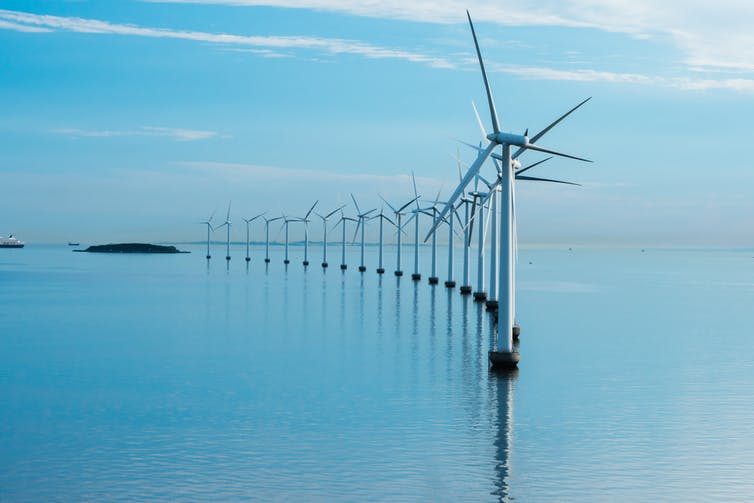An agreement between the renewable industry and the government will ensure that 30 percent of the British power consumption in 2030 comes from offshore wind power. This means tremendous growth in the years ahead. About 2 GW will be built a year, which means large investments, significant market opportunities and a greater need to “stock” their wind power, for example in Norwegian reservoirs. The gas demand will fall, but faster in the power sector than in the heat market.
The aim is to build up an industry that also creates a significant number of jobs. Greenpeace and other environmental organizations push Claire Perry, the minister responsible for the field, for even more ambitious plans.
Prologue by Bergensia
Photo: Marc Stuber
It will also drive even further the UK’s world-leadership in floating offshore wind and seek export opportunities in the new deep-water markets of Japan, South Korea, California, Taiwan and Europe.
Blogpost on LinkedIn by Stephen Bull,
SVP Wind and Low Carbon Solutions at Equinor
David Toke, University of Aberdeen
Now that Japanese giants Toshiba and Hitachi have walked away from UK nuclear power projects that had previously been abandoned by others, it has forced the government to reassess the pro-nuclear bias of its energy policy. Greg Clark, the UK business secretary, has recognised that nuclear power is no longer cost competitive with renewable energy, but don’t expect any extra push into the cheaper technology.
There is easily enough solar and wind energy available to make up for the cancellation of the nuclear projects and to produce the low-carbon electricity required to make the UK’s 2030 carbon emissions targets achievable. Instead, however, the country’s incentives and regulations favour developing more power plants driven by natural gas. Having hacked back emissions from power by over two-thirds since 1990, progress with decarbonising the grid risks coming to an end.
According to the UK parliament’s Committee on Climate Change, the UK needs to cut power emissions from about 265g of carbon dioxide per kilowatt hour in 2017 to under 100g by 2030. The government had been substantially relying on nuclear power to do this, having originally identified eight sites as viable for new plants. Six projects were taken forward, including Hitachi and Toshiba plants in Wales and Cumbria respectively.
Yet despite much larger government incentives than those available for renewables, most private nuclear builders are now steering clear, having seen the problems with new plants in the likes of the US and France. The only two projects still on the slate are a joint venture by EDF of France and CGN of China – both foreign state-owned companies. They are building the UK’s first new plant in over two decades, Hinkley C in south-west England; while also planning a second, Bradwell B, in the south east.
Nuclear and renewables
Even before the latest announcement that Hitachi’s Wylfa plant in Wales was being suspended, the Committee on Climate Change was already saying the UK needed to build more renewable capacity to reach its carbon reduction targets. Now the problem is even worse.
In 2018, 19% of the UK’s electricity was generated by nuclear plants. With most existing plants due to retire over the next few years, I calculate this may now fall to 10% by 2030 when you factor in the new-build cancellations. Solar and wind generation could easily more than make up for this. For years, renewables’ share of generation has been steadily rising. It reached 30% in 2018 and is due to reach 35% in 2020. But with no new incentives for onshore wind and solar and only limited incentives for offshore wind, it looks likely to fall far short of its potential.
The government incentivises renewable energy projects through so-called contracts for difference (CFD) auctions in which the most competitive bidders are granted contracts to supply electricity at fixed prices. This year, it is set to auction some new offshore wind farm contracts. Only a trickle of projects that don’t receive such incentives go ahead, so the number of contracts on offer effectively dictates how much offshore wind capacity will be built.
With offshore wind currently providing about 7% of generation, I have heard from informal soundings that the new contracts will add less than 10% more. In other words, it would at best offset the decline in nuclear. With no further contracts in the pipeline at present, it suggests low-carbon power in the UK is at a standstill.
Power politics
The reason why more renewables are not on the cards is because the Treasury is keen to limit energy incentives. It worries that the electricity price has been increasing – and hence the Treasury wants to strictly limit new incentives, the costs of which are added to electricity bills. This, however, ignores the fact that CFD prices will benefit from the falling cost of building offshore wind farms – the price has more than halved in three years. Nevertheless, the amount of money available to pay for the contracts is being limited to around half that being made available to owners of gas-fired power plants to supply capacity when the wind isn’t blowing.
If all 27GW of offshore wind power schemes in various stages of planning got contracts, I calculate it would supply around one-third of the total electricity requirement. Coupled with the remaining nuclear power and the renewables that are already onstream, that would reach the 75% of power that the Committee on Climate Change reckons needs to be coming from these low-carbon sources by 2030 to achieve the emissions targets. This is not counting potential offshore wind resources which are not even being mobilised, plus large possibilities for onshore wind and solar. Instead, gas-fired power looks set to supply around half of UK electricity by 2030, compared to 40% at present.
One government justification for being less generous to renewables is that unlike gas or nuclear, they do not represent “firm” power – in other words, they only generate when the wind is blowing or the sun is shining.
Proponents of renewable energy counter that you can reduce the generating capacity required by increasing the use of batteries to store power on the grid and by incentivising consumers to, say, use more power overnight when demand is lower.
Yet one other option that attracts less attention is that you also get spare “firm” capacity from small gas engines or open-cycle turbines. These can be built quickly and would only be sparingly needed in a system mostly supplied by renewables.
Based on my calculations using Hinkley C and Wylfa, they cost around one-twentieth of the projected cost of new nuclear power. They are also nearly half the price of large gas-fired “CCGT” plants. Instead, however, the government spends the lion’s share of its incentives pot on large conventional power plants, many of which would operate whether they were subsidised or not.

CAT SCAPE
The underlying obstacle seems to be political opposition within the Conservative Party. My understanding from renewable energy lobbying sources is that the government’s Department for Business, Energy and Industrial Strategy would like to promote renewable energy more, but is held back by the Treasury, which wants to leave it to “the market”.
The upshot is that government policy is offering large incentives to new nuclear, gas-fired power and also shale gas extraction – but, paradoxically, not many are actually being developed. Meanwhile the cheapest options – onshore wind, solar and offshore wind – are being discriminated against. The collapse of the UK’s nuclear power plans should be an opportunity to think again. How frustrating that decarbonising power is instead falling off the agenda.![]()
David Toke, Reader in Energy Policy, University of Aberdeen
This article is republished from The Conversation under a Creative Commons license. Read the original article.




